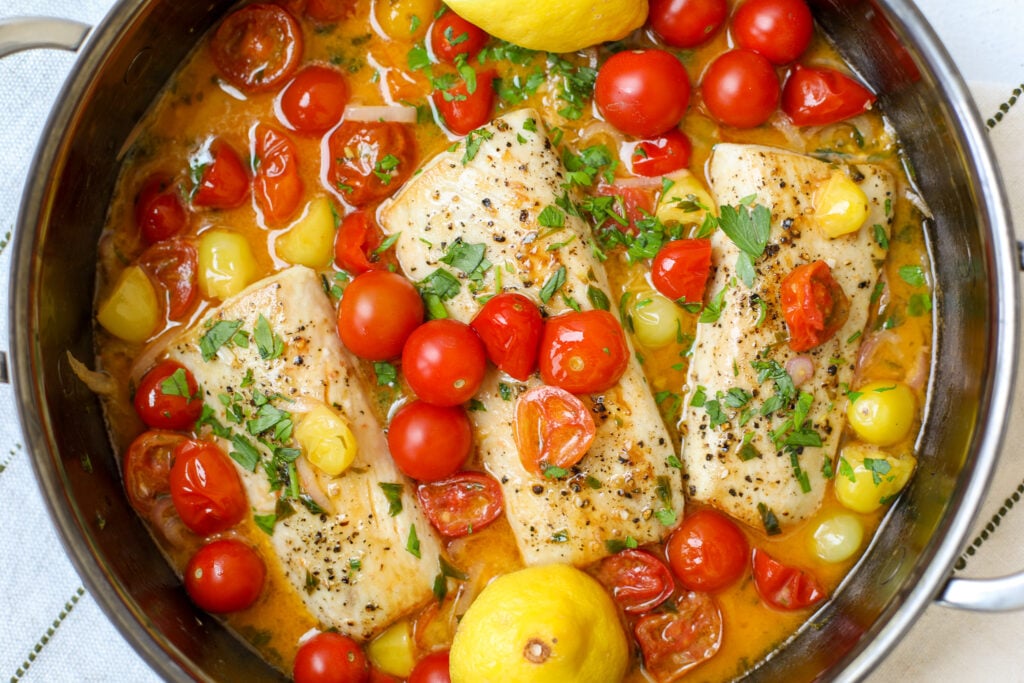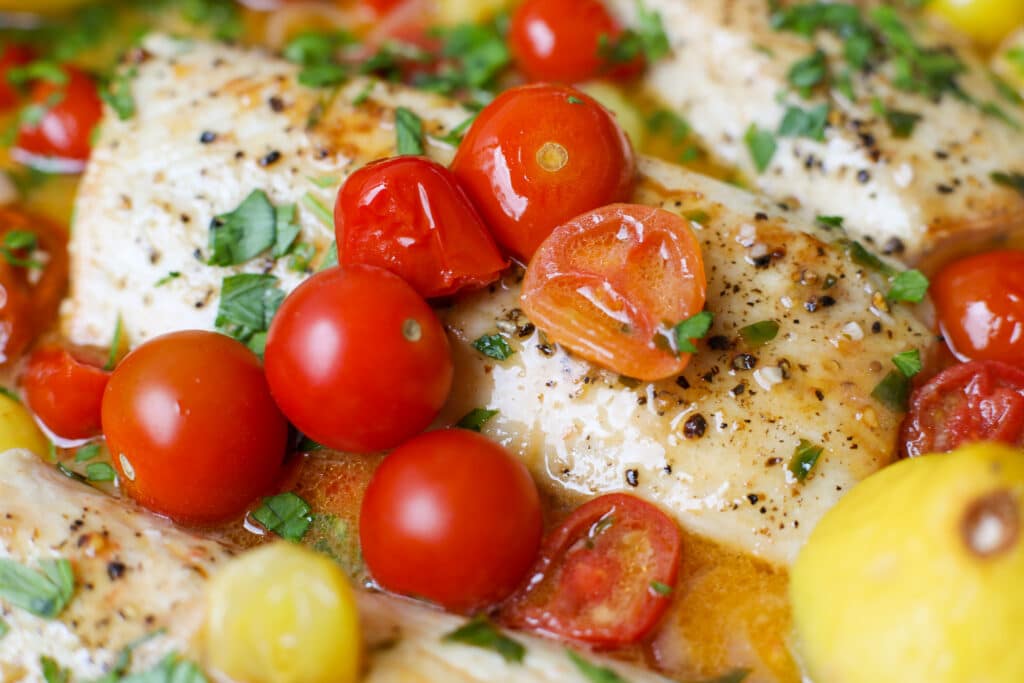Lemon Butter Mahi Mahi Recipe
Simple yet packed with flavor, this Lemon Butter Mahi Mahi might be one of my favorite fish recipes of all time. It comes together in under 30 minutes, and you only need one pan, meaning cleanup is a breeze.
When I’m in the mood for a flavorful restaurant-quality dish, I turn to this delicious skillet Mahi Mahi recipe. Just like Pan Seared Halibut with Lemon Butter and Lemon Butter Baked Cod, it features bright, citrus flavors and cooks quickly, making it perfect for any night of the week.

Believe it or not, cooking fish at home is not as intimidating as it’s made out to be. In fact, mahi is super easy to make, only requiring a quick sear on each side. Plus, when served with a simple side dish like linguini or roasted vegetables, you can have dinner on the table in no time at all.
This mahi recipe makes four light servings or two hearty dinner servings. So, I suggest doubling it if you’re entertaining a crowd or are just extra hungry!
What is Mahi Mahi?
Mahi Mahi is a mild-flavored, flaky white fish with a semi-sweet taste. It’s also known as dolphinfish, even though it’s not in the dolphin family whatsoever.
The flesh is firm and meaty while still maintaining a moist and tender texture. Mahi is a lean fish, nowhere near as oily as salmon. As a result, you have to be careful not to overcook it. Whether grilled, broiled, or seared, mahi usually only requires about 3-4 minutes of cooking time per side!
Recipe Ingredients
- Mahi Mahi – I used two 7-ounce boneless, skinless filets. Look for something similar, and remove the skin if it is still attached.
- Olive Oil – This coats the skillet, helping the mahi filets develop a nice, golden sear on the outside.
- Butter – Forms the base of the lemon butter sauce. Salted butter helps to season the sauce right from the start.
- Garlic – For the best flavor, mince fresh garlic.
- Lemon Juice – Freshly squeezed lemon juice adds acidity and brightness to the sauce, cutting through the butter’s rich flavor.
- Cherry Tomatoes – Cook these until they blister, which means their skins will soften and burst open. Their natural sweetness intensifies as they cook, adding an irresistible sweet yet savory taste to the dish.
- Shallot – This adds a mellow and delicate onion-like taste.
- Parsley – Fresh parsley is a bright and refreshing addition to the sauce. Like lemon juice, it cuts through the richness, lightening the butter sauce up a bit.
- Kosher Salt and Cracked Black Pepper – Adjust to taste.
- Chicken Stock – A small amount of chicken stock is used to combine the lemon butter sauce ingredients, making it more of a sauce than a sautéed mixture.

How to Make Lemon Butter Mahi Mahi
- Warm. Heat the olive oil in a sauté pan over medium high heat.
- Prepare. Pat the mahi dry with a paper towel, removing any excess moisture. Then, season the mahi mahi filets with kosher salt and cracked black pepper.
- Sear. Add the fish to the pan, and sear for 3 minutes on each side. Next, reduce the heat to low. Continue cooking the fish for another 1-2 minutes. Then, remove it from the pan, and set it aside.
- Cook. Using the same pan, add the butter and melt over medium heat. Once melted, add the shallots and minced garlic. Let it sweat for 1-2 minutes before adding the tomatoes.Season with kosher salt and cracked black pepper.
- Once the tomatoes have blistered, deglaze the pan with chicken stock. Once the chicken stock reduces, add the fresh squeezed lemon juice and chopped parsley. Simmer until the sauce reduces a touch.
- Assemble. Nestle the cooked mahi into the lemon butter sauce. Top it with a few spoonfuls of the sauce and some of the cooked tomatoes.
- Serve. Garnish the finished dish with freshly chopped parsley and sliced tomatoes, serve immediately, and enjoy!
Tips for Success
- When prepping the mahi, be sure to pat it dry with a paper towel. Soaking up the excess moisture helps you achieve a beautiful light sear on the fish.
- Season the fish with kosher salt and pepper right before adding it to the hot pan. If you let salted fish sit, the salt will draw moisture to the surface and prevent it from getting a golden brown sear.
- Be careful not to overcook the fish, as it can become tough and rubbery. Mahi mahi is fully cooked once it reaches an internal temperature of 145 degrees Fahrenheit when measured with a meat thermometer.
- If you’re doubling the recipe or using a smaller skillet, make sure you don’t overcrowd the pan. Sear the fish in batches if needed!
Serving Suggestions
For a heartier meal, enjoy fish recipe alongside starchy sides, such as pasta, rice, or mashed potatoes. Creamy Mashed Potatoes, Lebanese Rice, and Greek Pasta Salad are all great options.
Or, to keep the meal on the lighter side, serve Lemon Butter Mahi Mahi with roasted veggies or a fresh vegetable salad, like this Sautéed Spring Vegetable Salad.
Frequently Asked Questions
What does mahi taste like? Mild and less fishy-tasting than swordfish, mahi mahi is a firm yet tender and flaky white fish with a slightly sweet taste. It absorbs flavors well, making it a versatile fresh fish option.
Can I use a different type of fish? Flaky, mild-tasting white fish such as cod, haddock, and halibut can all be substituted for mahi mahi. The texture and flavor will differ slightly depending on the type of fish you choose, but overall, these are reliable substitutes.
How long do leftovers last? Stored in an airtight container in the refrigerator, leftovers will stay fresh for three to four days. Reheat your mahi mahi with tomatoes and lemon butter sauce in the microwave just until warmed through.
Can I freeze this recipe? Yes, you can freeze this mahi mahi recipe in a freezer-safe container for up to three months!

Lemon Butter Mahi Mahi Recipe
Equipment
- 1 saute pan
Ingredients
- 1-2 tablespoons olive oil
- 14 ounces mahi mahi, two 7 ounce filets or similar
- 6 tablespoons butter
- ½ cup shallot, finely diced
- 1 tablespoon garlic, minced, about 2-3 cloves
- 1.5 cups cherry tomatoes
- pinch kosher salt, to season
- few turns cracked black pepper , to season
- ¼-⅓ cup chicken stock, deglaze the pan
- 2 tablespoons lemon juice, fresh squeezed
- 1.5 tablespoons parsley , chopped small, extra as garnish
Instructions
Warm
- Heat the olive oil in a sauté pan over medium high heat.
Prepare
- Pat the mahi mahi dry with a paper towel, removing any excess moisture. Then, season the mahi mahi filets with kosher salt and cracked black pepper.
Sear
- Add the fish to the pan, and sear for 3 minutes on each side. Next, reduce the heat to low. Continue cooking the fish for another 1-2 minutes. Then, remove it from the pan, and set it aside.
Cook
- Using the same pan, add the butter and melt over medium heat. Once melted, add the shallots and minced garlic. Let them sweat for 1-2 minutes before adding the tomatoes. Season with kosher salt and cracked black pepper. Once the tomatoes have blistered, deglaze the pan with chicken stock. Once the chicken stock reduces, add the fresh squeezed lemon juice and chopped parsley. Simmer until the sauce reduces a touch.
Assemble
- Nestle the cooked mahi mahi into the lemon butter sauce. Top it with a few spoonfuls of the sauce and some of the cooked tomatoes. Garnish the finished dish with freshly chopped parsley and tomatoes, serve immediately, and enjoy!


11 Comments on “Lemon Butter Mahi Mahi Recipe”
Awesome recipe! Thanks for sharing! I usually struggle to cook a nice fish, but this was so simple and easy to follow. The fish was cooked thoroughly and nice and flaky.
So glad you enjoyed!
Yum!! I don’t make mahi often, but this recipe was amazing and is going to be my go to. Thank you!
So glad you enjoyed it!
This sauce is a great sauce for a lot of food. I’d like more lemon juice, less garlic. The fish was cooked perfectly. The brown rice soaked up the juices nicely. Very easy. Pantry staples. Thank you.
This was delicious!! I added some white wine with the chicken broth. Had it over linguine and topped with grated parm!
This was AMAZING!!! If I could give it 10 stars I would! The hubs deep sea fishes and I hunt for recipes to use for his fresh catch, this by far was our favorite. Thank you!! Yummy!!
This was great! Very easy. (I did skip the shallots and upped the garlic, and used white wine because all I had was beef stock.) Cooking time for the fish was just right. Added crushed red pepper and served over linguine. Just the recipe I was looking for so thank you!
Made this tonight for dinner and it was, fast, easy, and delicious! I didn’t have shallots so I subbed onions and it was still amazing. Even my 6 year old who doesn’t like fish that much ate it!
Awesome recipe – simple, and very good directions. I usually have to make changes to the cooking time, but this one was perfect! Even my little kids liked it. Delicious!
This is one of the most delicious fish delishes I’ve ever made. It was hearty, but not heavy. The citrus gave it such a burst of flavor while the shallots and garlic gave it a subtle kick. I would eat this again and again! Delicious!